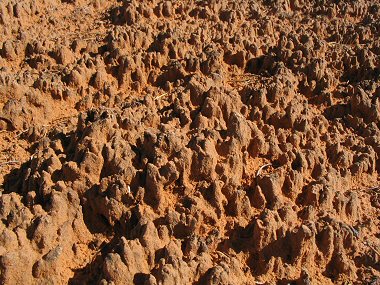Cryptobiotic soil is found throughout the world. In arid
regions, these living soil crusts are dominated by cyanobacteria, and
also include soil lichens, mosses, green algae, micofungi and bacteria.
These crusts play an important role in the ecosystems in which they
occur. In the high deserts of the Colorado Plateau (which include parts
of Utah, Arizona, Colorado and New Mexico), these knobby black crusts are extraordinarily
well-developed and may represent 70 to 80 percent of the living ground
cover.
New Mexico), these knobby black crusts are extraordinarily
well-developed and may represent 70 to 80 percent of the living ground
cover.
|
The text on this page was taken
from an NPS publication. It is interesting to note that livestock
impacts (which in my experience create some of the more
significant amounts of soil damage) are not mentioned. |
Cyanobacteria, also called blue-green algae, are one
of the oldest known life forms. It is thought that these organisms were
among the first land colonizers of the earth's early land masses, and
played an integral role in the formation and stabilization of the
earth's early soils. The earliest cyanobacteria fossils found are called
stromatolites, which date back more than 3.5 billion years. Extremely
thick mats of these organisms converted the earth's original carbon
dioxide-rich atmosphere into one rich in oxygen and capable of
sustaining life.
Cyanobacteria occur as single cells or as filaments. The most common
form found in Colorado Plateau soils are the filamentous type, which are
usually surrounded by sticky mucilaginous sheaths.
When moistened, cyanobacteria become active, moving through the soil and
leaving a trail of sticky material behind. The sheath material sticks
to surfaces such as rock or soil particles, forming an intricate web of
fibers throughout the soil. In this way, loose soil particles are joined
together, and an otherwise unstable surface becomes very resistant to
both wind and water erosion.
The soil-binding action is not dependent on the presence of living
filaments. Layers of abandoned sheaths, built up over long periods of
time, can still be found clinging tenaciously to soil particles,
providing cohesion and stability in sandy soils at depths up to 10cm.
Nitrogen fixation is another significant capability of cyanobacteria.
Vascular plants are unable to utilize nitrogen as it occurs in the
atmosphere. Cyanobacteria are able to convert atmospheric nitrogen to a
form plants can use. This is especially important in desert ecosystems,
where nitrogen levels are low and often limiting to plant productivity.
The sheaths have other functions as well. When moistened, they swell up
to ten times their dry size. This ability to intercept and store water
benefits both the crustal organisms as well as vascular plants,
especially in arid regions with sporadic rainfall.
Sheaths, and the organisms they surround, also contribute organic matter
and help make essential nutrients available to vascular plants.
Negatively charged clay particles, often found clinging to the sheaths,
bind positively-charged nutrients, preventing them from being leached
out of the upper soil horizons or becoming bound in a form unavailable
to plants. Like soil stability, this function is not dependent on the
presence of living filaments, but only the presence of sheath material.
Unfortunately, many human activities are incompatible with the presence
and well-being of cryptobiotic soils. The fibers that confer such
tensile strength to these crusts are no match for the compressional
stress placed on them by footprints or machinery, especially when the
crusts are dry and brittle.
Air pollutants, both from urban areas and coal-fired power plants, also
adversely affect the physiology of these crusts.
Tracks in continuous strips, such as those produced by vehicles or
bicycles, are especially damaging, creating areas that are highly
vulnerable to wind and water erosion. Rainfall carries away loose
material, often creating channels along these tracks, especially when
they occur on slopes.
Wind not only blows pieces of the pulverized crust away, thereby
preventing reattachment to disturbed areas, but also disturbs the
underlying loose soil, often covering nearby crusts. Since crustal
organisms need light to photosynthesize, burial can mean death. When
large sandy areas are impacted during dry periods, previously stable
areas can become a series of shifting sand dunes in just a few years.
Impacted areas may never fully recover. Under the best circumstances, a
thin veneer of cryptobiotic soil may return in five to seven years.
Damage is repaired slowly during up the 50 years of cyanobacterial
growth. Lichens and mosses may take even longer to recover.
|

